Influence of Epoxy Resin Treatment on the Mechanical and Tribological Properties of Hemp-Fiber-Reinforced Plant-Derived Polyamide 1010 Biomass Composites
Abstract
:1. Introduction
2. Results and Discussion
2.1. Fourier-Transform Infrared (FT-IR) Analysis of Fiber Surface
2.2. Morphology of HF/PA1010 Biomass Composites
2.3. Thermogravimetric Analysis
2.4. Mechanical Properties
- NaClO2 alkaline treatment removes sub-components such as lignin, wax, and hemicellulose from the HF surface, increases the surface roughness, and, moreover, generates hydroxyl groups.
- The silane coupling agent generates alkoxysilane groups, which after hydrolysis are capable of reacting with OH-rich fiber surfaces [58]. Therefore, after HF is treated by NaClO2, the condensation reaction between the silanol groups of the ureidosilane coupling agent (A-1160) and the hydroxyl groups on the surface of HF can occur more easily.
- Ureido groups in A-1160 can cause hydrogen bonding with hydroxyl groups and epoxy groups in epoxy resin. This reinforces the interfacial interaction between A-1160 and epoxy resin, enhancing the compatibility between two phases.
- Chemical reactions between epoxy groups in epoxy resin and highly reactive functional groups such as amine and carboxyl end groups in the molecular chain of polyamides can occur more easily.
2.5. Tribological Properties
2.6. Limiting pv Value
3. Materials and Methods
3.1. Materials
3.2. Processing
3.3. Experimental Method
4. Conclusions
- Mechanical properties such as tensile strength, tensile modulus, bending strength and bending modulus of HF/PA1010 biomass composites improved with surface treatment using epoxy resin.
- The specific wear rate by the constant normal load and constant sliding velocity test for HF/PA1010 biomass composites significantly improved with surface treatment using epoxy resin, although the frictional coefficient of epoxy-resin-treated HF/PA1010 biomass composites was higher than that of ureidosilane-treated HF/PA1010 biomass composites.
- The morphologies of the metallic counterface, wear debris, and worn surface differed according to the type of surface treatment carried out. These behaviors may be due to the change in the mode of friction and wear mechanism according to the type of surface treatment, caused by interfacial interaction between HF and PA1010 and fiber dispersion of HF in the composites.
- The limiting pv value by the step load method improved when HFs in HF/PA1010 biomass composites were surface-treated using epoxy resin. These tendencies are similar to the mechanical properties of these biomass composites, such as tensile and bending properties.
- In particular, pre-treatment combining NaClO2 alkaline treatment and the use of an ureidosilane coupling agent (NaClO2 + A-1160) is better than NaClO2 alkaline treatment alone, before surface treatment using epoxy resin for enhancing the thermal stability, strength, modulus, specific wear rate, and limiting pv value of HF/PA1010 biomass composites.
- In conclusion, surface treatment using epoxy resin after surface treatment with NaClO2 alkaline and an ureidosilane coupling agent (NaClO2 + A-1160 + EP) is most effective for enhancing the mechanical and tribological properties of HF/PA1010 biomass composites.
Author Contributions
Funding
Institutional Review Board Statement
Informed Consent Statement
Data Availability Statement
Acknowledgments
Conflicts of Interest
Sample Availability
References
- Kalia, S.; Kaith, B.S.; Kaur, I. Pretreatments of natural fibers and their application as reinforcing material in polymer composites. Polym. Eng. Sci. 2009, 49, 1253–1272. [Google Scholar] [CrossRef]
- De Rosa, I.M.; Kenny, J.M.; Puglia, D.; Santulli, C.; Sarasini, F. Morphological, thermal and mechanical characterization of okra (Abelmoschus esculentus) fibres as potential reinforcement in polymer composites. Compos. Sci. Technol. 2010, 70, 116–122. [Google Scholar] [CrossRef]
- Faruk, O.; Bledzki, A.K.; Fink, H.-P.; Sain, M. Biocomposites reinforced with natural fibers: 2000–2010. Prog. Polym. Sci. 2012, 37, 1552–1596. [Google Scholar] [CrossRef]
- Russo, P.; Carfagna, C.; Cimino, F.; Acierno, D.; Persico, P. Biodegradable composites reinforced with kenaf fibers: Thermal, mechanical, and morphological issues. Adv. Polym. Technol. 2013, 32, E313–E322. [Google Scholar] [CrossRef]
- Hashmi, S.A.R.; Dwivedi, U.K.; Chand, N. Friction and sliding wear of UHMWPE modified cotton fibre reinforced polyester composites. Tribol. Lett. 2006, 21, 79–87. [Google Scholar] [CrossRef]
- Kajiyama, T.; Yasuda, T.; Mimoto, S.; Shimizu, K.; Hayashi, K.; Yamanaka, T.; Murakami, M. Effect of hexamethylene diisocyanate as compatibilizer on the mechanical properties of banana fiber/poly(butylene succinate) composites. Int. Polym. Process. 2013, 28, 58–63. [Google Scholar] [CrossRef]
- Wang, F.; Lu, M.; Zhou, S.; Lu, Z.; Ran, S. Effect of fiber surface modification on the interfacial adhesion and thermo-mechanical performance of unidirectional epoxy-based composites reinforced with bamboo fibers. Molecules 2019, 24, 2682. [Google Scholar] [CrossRef] [PubMed] [Green Version]
- Dominici, F.; García, D.G.; Fombuena, V.; Luzi, F.; Puglia, D.; Torre, L.; Balart, R. Bio-Polyethylene-Based composites reinforced with alkali and palmitoyl chloride-treated coffee silverskin. Molecules 2019, 24, 3113. [Google Scholar] [CrossRef] [PubMed] [Green Version]
- Mazur, K.; Kuciel, S. Mechanical and hydrothermal aging behaviour of polyhydroxybutyrate-co-valerate (PHBV) composites reinforced by natural fibres. Molecules 2019, 24, 3538. [Google Scholar] [CrossRef] [Green Version]
- Balint, T.; Chang, B.P.; Mohanty, A.K.; Misra, M. Underutilized agricultural co-product as a sustainable biofiller for polyamide 6,6: Effect of carbonization temperature. Molecules 2020, 25, 1455. [Google Scholar] [CrossRef] [PubMed] [Green Version]
- Yiga, V.A.; Lubwama, M.; Pagel, S.; Benz, J.; Olupot, P.W.; Bonten, C. Flame retardancy and thermal stability of agricultural residue fiber-reinforced polylactic acid: A review. Polym. Compos. 2020, 42, 15–44. [Google Scholar] [CrossRef]
- Nishitani, Y.; Kajiyama, T.; Yamanaka, T. Effect of silane coupling agent on tribological properties of hemp fiber-reinforced plant-derived polyamide 1010 biomass composites. Materials 2017, 10, 1040. [Google Scholar] [CrossRef] [PubMed]
- Koronis, G.; Silva, A.; Fontul, M. Green composites: A review of adequate materials for automotive applications. Compos. B Eng. 2013, 44, 120–127. [Google Scholar] [CrossRef]
- Chand, N.; Fahim, M. Tribology of Natural Fiber Polymer Composites, 1st ed.; Woodhead Publishing: Cambridge, UK, 2008; pp. 1–205. ISBN 978-184-569-393-0. [Google Scholar]
- Nirmal, U.; Hashim, J.; Low, K.O. Adhesive wear and frictional performance of bamboo fibres reinforced epoxy composite. Tribol. Int. 2012, 47, 122–133. [Google Scholar] [CrossRef]
- Nirmal, U.; Hashim, J.; Megat Ahmad, M.M.H. A review on tribological performance of natural fibre polymeric composites. Tribol. Int. 2015, 83, 77–104. [Google Scholar] [CrossRef]
- Plackett, D.; Andersen, T.L.; Pedersen, W.B.; Nielsen, L. Biodegradable composites based on L-Polylactide and jute fibres. Compos. Sci. Technol. 2003, 63, 1287–1296. [Google Scholar] [CrossRef]
- Huda, M.S.; Drzal, L.T.; Mohanty, A.K.; Misra, M. Effect of fiber surface-treatments on the properties of laminated biocomposites from poly(lactic acid) (PLA) and kenaf fibers. Compos. Sci. Technol. 2008, 68, 424–432. [Google Scholar] [CrossRef]
- Le Duigou, A.; Davies, P.; Baley, C. Macroscopic analysis of interfacial properties of flax/PLLA biocomposites. Compos. Sci. Technol. 2010, 70, 1612–1620. [Google Scholar] [CrossRef] [Green Version]
- Bajpai, P.K.; Singh, I.; Madaan, J. Tribological behavior of natural fiber reinforced PLA composites. Wear 2013, 297, 829–840. [Google Scholar] [CrossRef]
- Bledzki, A.K.; Gassan, J. Composites reinforced with cellulose based fibres. Prog. Polym. Sci. 1999, 24, 221–274. [Google Scholar] [CrossRef]
- John, M.J.; Thomas, S. Biofibres and biocomposites. Carbohydr. Polym. 2008, 71, 343–364. [Google Scholar] [CrossRef]
- Oliver-Ortega, H.; Granda, L.A.; Espinach, F.X.; Mendez, J.A.; Julian, F.; Mutjé, P. Tensile properties and micromechanical analysis of stone groundwood from softwood reinforced bio-based polyamide11 composites. Compos. Sci. Technol. 2016, 132, 123–130. [Google Scholar] [CrossRef]
- Nishitani, Y.; Yamanaka, T.; Kajiyama, T.; Kitano, T. Thermal properties of hemp fiber reinforced plantderived polyamide biomass composites and their dynamic viscoelastic properties in molten state. In Viscoelastic and Viscoplastic Materials; El-Amin, M., Ed.; InTech: Rijeka, Croatia, 2016; pp. 53–79. [Google Scholar]
- Russo, P.; Simeoli, G.; Vitiello, L.; Filippone, G. Bio-Polyamide 11 hybrid composites reinforced with basalt/flax interwoven fibers: A tough green composite for semi-structural applications. Fibers 2019, 7, 41. [Google Scholar] [CrossRef] [Green Version]
- Tanasă, F.; Zănoagă, M.; Teacă, C.-A.; Nechifor, M.; Shahzad, A. Modified hemp fibers intended for fiber-reinforced polymer composites used in structural applications—A review. I. Methods of modification. Polym. Compos. 2020, 41, 5–31. [Google Scholar] [CrossRef]
- Yilmaz, N.D.; Powell, N.B.; Banks-Lee, P.; Michielsen, S. Hemp-Fiber based nonwoven composites: Effects of alkalization on sound absorption performance. Fibers Polym. 2012, 13, 915–922. [Google Scholar] [CrossRef]
- Wei, L.; McDonald, A.G. A review on grafting of biofibers for biocomposites. Materials 2016, 9, 303. [Google Scholar] [CrossRef]
- Sreekala, M.S.; Thomas, S. Effect of fibre surface modification on water-sorption characteristics of oil palm fibres. Compos. Sci. Technol. 2003, 63, 861–869. [Google Scholar] [CrossRef]
- Mishra, S.; Naik, J.B.; Patil, Y.P. The compatibilising effect of maleic anhydride on swelling and mechanical properties of plant-fiber-reinforced novolac composites. Compos. Sci. Technol. 2000, 60, 1729–1735. [Google Scholar] [CrossRef]
- Kajiyama, T.; Yamanaka, T.; Kawasaki, K.; Sugawara, N.; Nishitani, Y. Influence of maleic anhydride treatment on the tribological properties of hemp fiber reinforced plant-derived polyamide 1010 biomass composites. In Proceedings of the Polymer Processing Society 33rd Annual Meeting (PPS-33), Cancun, Mexico, 10–14 December 2017. [Google Scholar]
- Pickering, K.L.; Efendy, M.G.A.; Le, T.M. A review of recent developments in natural fibre composites and their mechanical performance. Compos. Part A Appl. Sci. Manuf. 2016, 83, 98–112. [Google Scholar] [CrossRef] [Green Version]
- Baltazar-y-Jimenez, A.; Bistritz, M.; Schulz, E.; Bismarck, A. Atmospheric air pressure plasma treatment of lignocellulosic fibres: Impact on mechanical properties and adhesion to cellulose acetate butyrate. Compos. Sci. Technol. 2008, 68, 215–227. [Google Scholar] [CrossRef] [Green Version]
- Rahman, G.M.S.; Mamun, M.A.A.; Khan, M.A. Effect of γ (Gamma)-Radiation on the physico-mechanical properties of grafted jute fabric reinforced polypropylene (PP) composites. Fibers Polym. 2014, 15, 340–346. [Google Scholar] [CrossRef]
- El-Tayeb, N.S.M. A study on the potential of sugarcane fibers/polyester composite for tribological applications. Wear 2008, 265, 223–235. [Google Scholar] [CrossRef]
- Omrani, E.; Menezes, P.L.; Rohatgi, P.K. State of the art on tribological behavior of polymer matrix composites reinforced with natural fibers in the green materials world. JESTECH 2016, 19, 717–736. [Google Scholar] [CrossRef] [Green Version]
- Nirmal, U.; Yousif, B.F.; Rilling, D.; Brevern, P.V. Effect of betelnut fibres treatment and contact conditions on adhesive wear and frictional performance of polyester composites. Wear 2010, 268, 1354–1370. [Google Scholar] [CrossRef] [Green Version]
- Goriparthi, B.K.; Suman, K.N.S.; Mohan Rao, N. Effect of fiber surface treatments on mechanical and abrasive wear performance of polylactide/jute composites. Compos. Part A Appl. Sci. Manuf. 2012, 43, 1800–1808. [Google Scholar] [CrossRef]
- Chand, N.; Dwivedi, U.K. Effect of coupling agent on abrasive wear behaviour of chopped jute fibre-reinforced polypropylene composites. Wear 2006, 261, 1057–1063. [Google Scholar] [CrossRef]
- Chand, N.; Dwivedi, U.K. Sliding wear and friction characteristics of sisal fibre reinforced polyester composites: Effect of silane coupling agent and applied load. Polym. Compos. 2008, 29, 280–284. [Google Scholar] [CrossRef]
- Enciso, B.; Abenojar, J.; Martínez, M.A. Effect of APPT treatment on mechanical properties and durability of green composites with woven flax. Materials 2020, 13, 4762. [Google Scholar] [CrossRef]
- Liu, Y.; Xie, J.; Wu, N.; Wang, L.; Ma, Y.; Tong, J. Influence of silane treatment on the mechanical, tribological and morphological properties of corn stalk fiber reinforced polymer composites. Tribol. Int. 2019, 131, 398–405. [Google Scholar] [CrossRef]
- Chandgude, S.; Salunkhe, S. Biofiber-Reinforced polymeric hybrid composites: An overview on mechanical and tribological performance. Polym. Compos. 2020, 41, 3908–3939. [Google Scholar] [CrossRef]
- Paul, R.; Gouda, K.; Bhowmik, S. Effect of Different constraint on tribological behaviour of natural fibre/filler reinforced polymeric composites: A review. Silicon 2020. [Google Scholar] [CrossRef]
- Hasumi, M.; Nishitani, Y.; Kitano, T. Effect of surface treatment on the mechanical properties of hemp fiber reinforced polyamide 1010 composites. In Proceedings of the Polymer Processing Society 28th Annual Meeting (PPS-28), Pattaya, Thailand, 11–15 December 2012. [Google Scholar]
- Mukaida, J.; Nishitani, Y.; Kitano, T. Effect of addition of plants-derived polyamide 11 elastomer on the mechanical and tribological properties of hemp fiber reinforced polyamide 1010 composites. AIP Conf. Proc. 2015, 1664, 060008. [Google Scholar] [CrossRef] [Green Version]
- Nishitani, Y.; Mukaida, J.; Yamanaka, T.; Kajiyama, T.; Kitano, T. Effect of processing sequence on the dynamic viscoelastic properties of ternary biomass composites (Hemp fiber/PA1010/PA11E) in the molten state. AIP Conf. Proc. 2016, 1779, 060004. [Google Scholar] [CrossRef] [Green Version]
- Mukaida, J.; Nishitani, Y.; Yamanaka, T.; Kajiyama, T.; Kitano, T. Influence of types of alkali treatment on the mechanical properties of hemp fiber reinforced polyamide 1010 composites. AIP Conf. Proc. 2015, 1779, 060005. [Google Scholar] [CrossRef] [Green Version]
- Nishitani, Y.; Mukaida, J.; Yamanaka, T.; Kajiyama, T.; Kitano, T. Influence of initial fiber length on the mechanical and tribological properties of hemp fiber reinforced plants-derived polyamide 1010 biomass composites. AIP Conf. Proc. 2017, 1914, 070003. [Google Scholar] [CrossRef] [Green Version]
- Nishitani, Y.; Ito, Y.; Kajiyama, T. Effect of addition of PP-g-MA on the tribological properties of hemp fiber reinforced plant-derived polyamide1010 biomass composites. AIP Conf. Proc. 2019, 2065, 040007. [Google Scholar] [CrossRef]
- Le Troedec, M.; Sedan, D.; Peyratout, C.; Bonnet, J.P.; Smith, A.; Guinebretiere, R.; Gloaguen, V.; Krausz, P. Influence of various chemical treatments on the composition and structure of hemp fibres. Compos. Part A Appl. Sci. Manuf. 2008, 39, 514–522. [Google Scholar] [CrossRef]
- Sgriccia, N.; Hawley, M.C.; Misra, M. Characterization of natural fiber surfaces and natural fiber composites. Compos. Part A Appl. Sci. Manuf. 2008, 39, 1632–1637. [Google Scholar] [CrossRef]
- Sawpan, M.A.; Pickering, K.L.; Fernyhough, A. Effect of various chemical treatments on the fibre structure and tensile properties of industrial hemp fibres. Compos. Part A Appl. Sci. Manuf. 2011, 42, 888–895. [Google Scholar] [CrossRef] [Green Version]
- Valadez-Gonzalez, A.; Cervantes-Uc, J.M.; Olayo, R.; Herrera-Franco, P.J. Chemical modification of henequen fibers with an organosilane coupling agent. Compos. B Eng. 1999, 30, 321–331. [Google Scholar] [CrossRef]
- Pothan, L.A.; Bellman, C.; Kailas, L.; Thomas, S. Influence of chemical treatments on the electrokinetic properties of cellulose fibres. J. Adhes. Sci. Technol. 2002, 16, 157–178. [Google Scholar] [CrossRef]
- Nishioka, T.; Housaki, T. A Guide on Plastic Analysis; Maruzen Publishing Co., Ltd.: Tokyo, Japan, 2011; pp. 213–224. ISBN 978-462-108-444-1. [Google Scholar]
- Lu, N.; Oza, S. Thermal stability and thermo-mechanical properties of hemp-high density polyethylene composites: Effect of two different chemical modifications. Compos. B Eng. 2013, 44, 484–490. [Google Scholar] [CrossRef]
- Gironès, J.; Méndez, J.A.; Boufi, S.; Vilaseca, F.; Mutjé, P. Effect of silane coupling agents on the properties of pine fibers/polypropylene composites. J. Appl. Polym. Sci. 2007, 103, 3706–3717. [Google Scholar] [CrossRef]
- Suresh Kumar, S.M.; Duraibabu, D.; Subramanian, K. Studies on mechanical, thermal and dynamic mechanical properties of untreated (raw) and treated coconut sheath fiber reinforced epoxy composites. Mater. Des. 2014, 59, 63–69. [Google Scholar] [CrossRef]
- Mohanty, S.; Verma, S.K.; Nayak, S.K. Dynamic mechanical and thermal properties of MAPE treated jute/HDPE composites. Compos. Sci. Technol. 2006, 66, 538–547. [Google Scholar] [CrossRef]
- Yu, T.; Ren, J.; Li, S.; Yuan, H.; Li, Y. Effect of fiber surface-treatments on the properties of poly(lactic acid)/ramie composites. Compos. Part A Appl. Sci. Manuf. 2010, 41, 499–505. [Google Scholar] [CrossRef]
- Etaati, A.; Pather, S.; Fang, Z.; Wang, H. The study of fibre/matrix bond strength in short hemp polypropylene composites from dynamic mechanical analysis. Compos. B Eng. 2014, 62, 19–28. [Google Scholar] [CrossRef]
- Zeng, H.; Gao, C.; Wang, Y.; Watts, P.C.P.; Kong, H.; Cui, X.; Yan, D. In situ polymerization approach to multiwalled carbon nanotubes-reinforced nylon 1010 composites: Mechanical properties and crystallization behavior. Polymer 2006, 47, 113–122. [Google Scholar] [CrossRef]
- Bahadur, S. The development of transfer layers and their role in polymer tribology. Wear 2000, 245, 92–99. [Google Scholar] [CrossRef]
- Nishitani, Y.; Yamada, Y.; Ishii, C.; Sekiguchi, I.; Kitano, T. Effects of addition of functionalized SEBS on rheological, mechanical, and tribological properties of polyamide 6 nanocomposites. Polym. Eng. Sci. 2010, 50, 100–112. [Google Scholar] [CrossRef]
- Lancaster, J.K. Estimation of the limiting PV relationships for thermoplastic bearing materials. Tribology 1971, 4, 82–86. [Google Scholar] [CrossRef]
- Yamaguchi, Y.; Kashiwagi, K. The limiting pressure-velocity (PV) of plastics under unlubricated sliding. Polym. Eng. Sci. 1982, 22, 248–253. [Google Scholar] [CrossRef]
- Song, F.; Wang, Q.; Wang, T. The effects of crystallinity on the mechanical properties and the limiting PV (pressure × velocity) value of PTFE. Tribol. Int. 2016, 93, 1–10. [Google Scholar] [CrossRef]

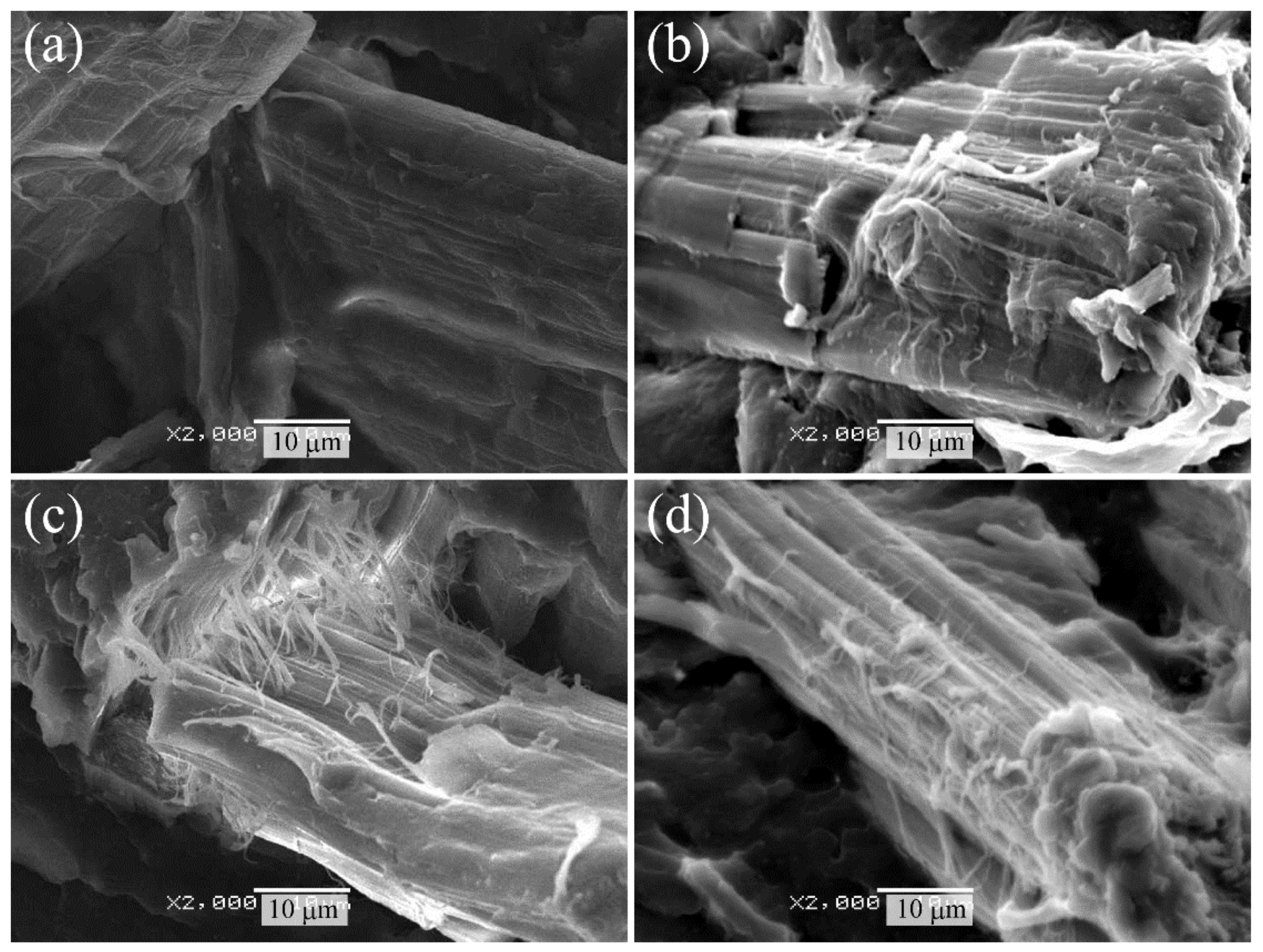



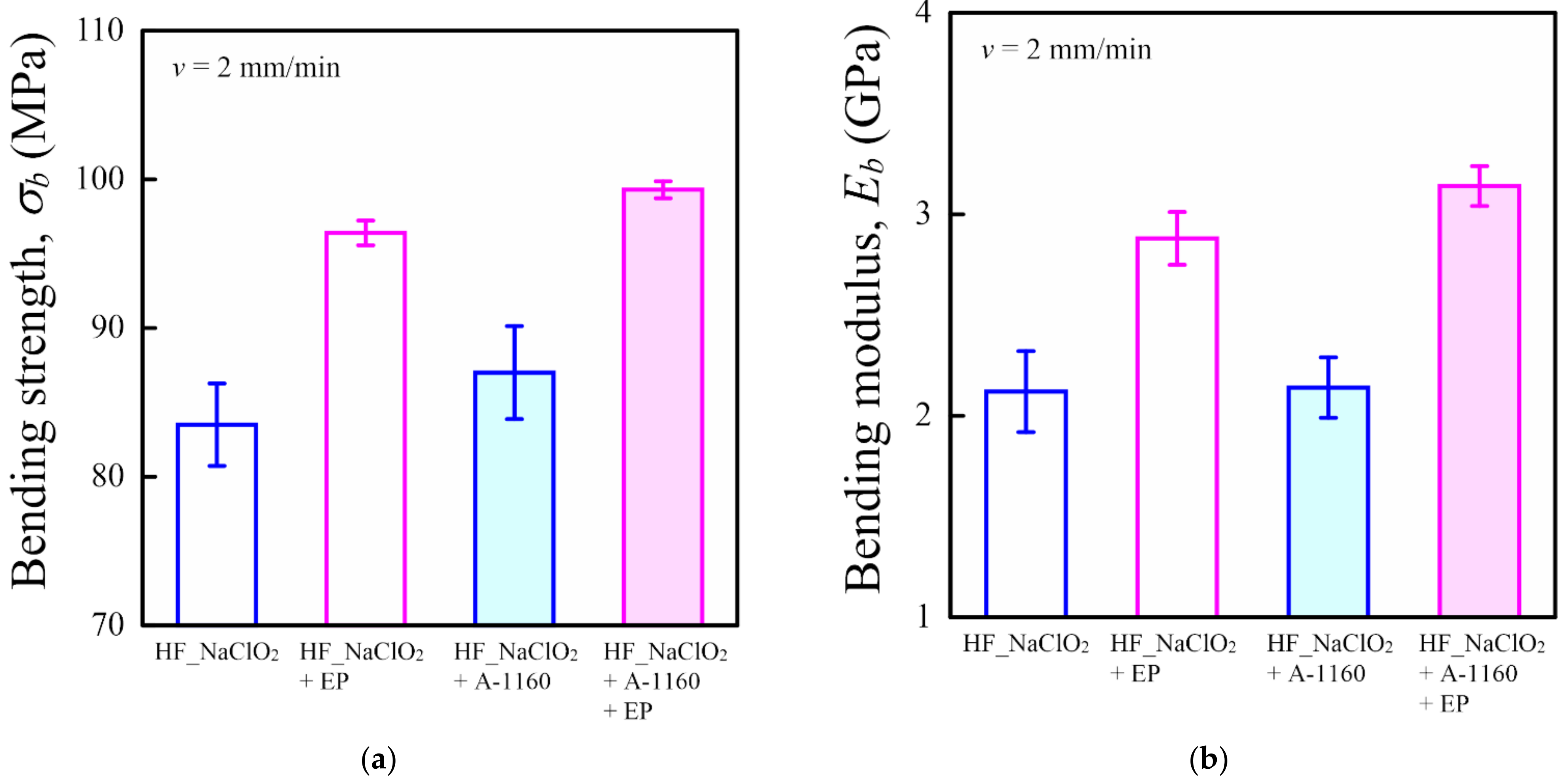


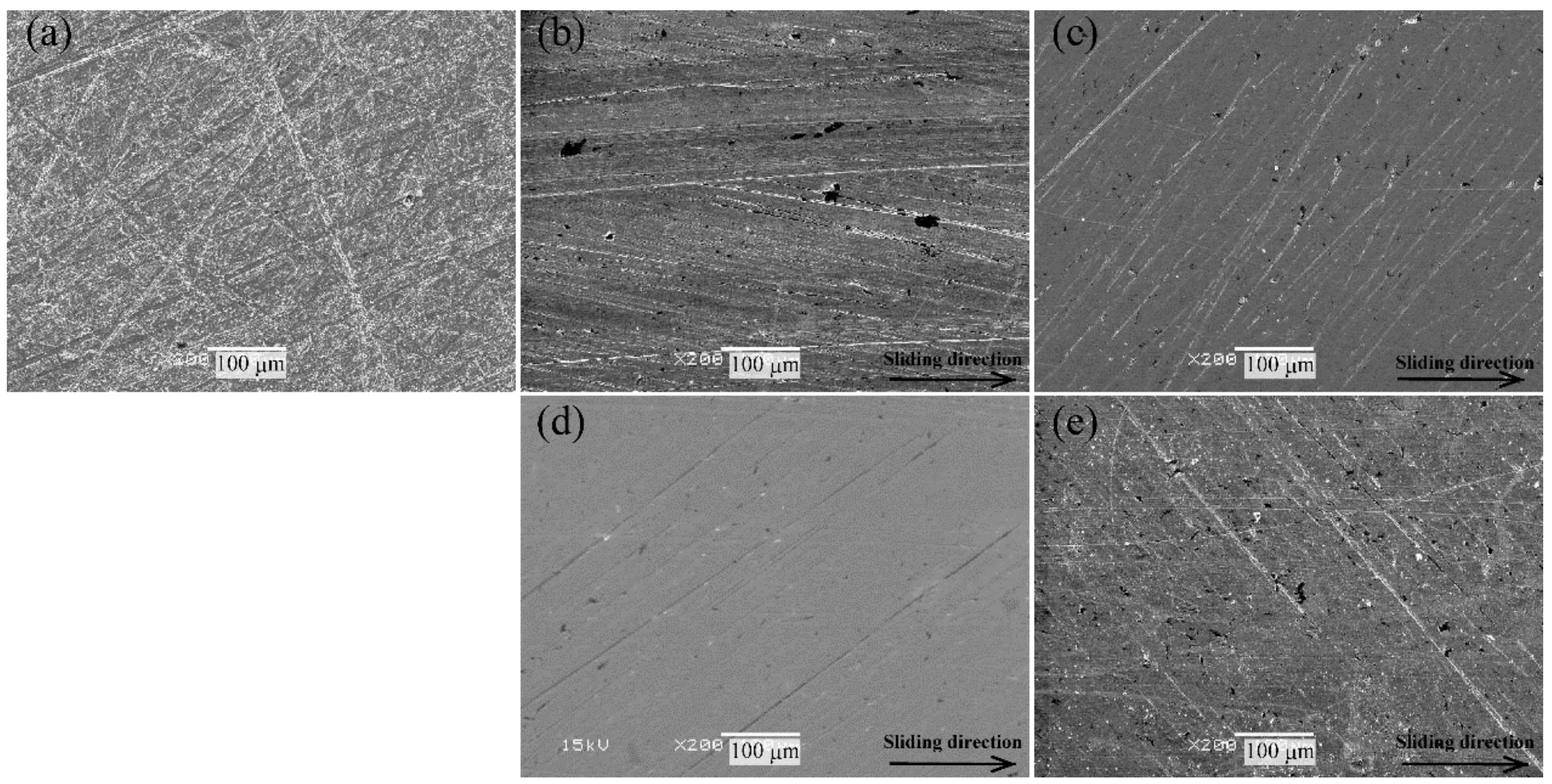

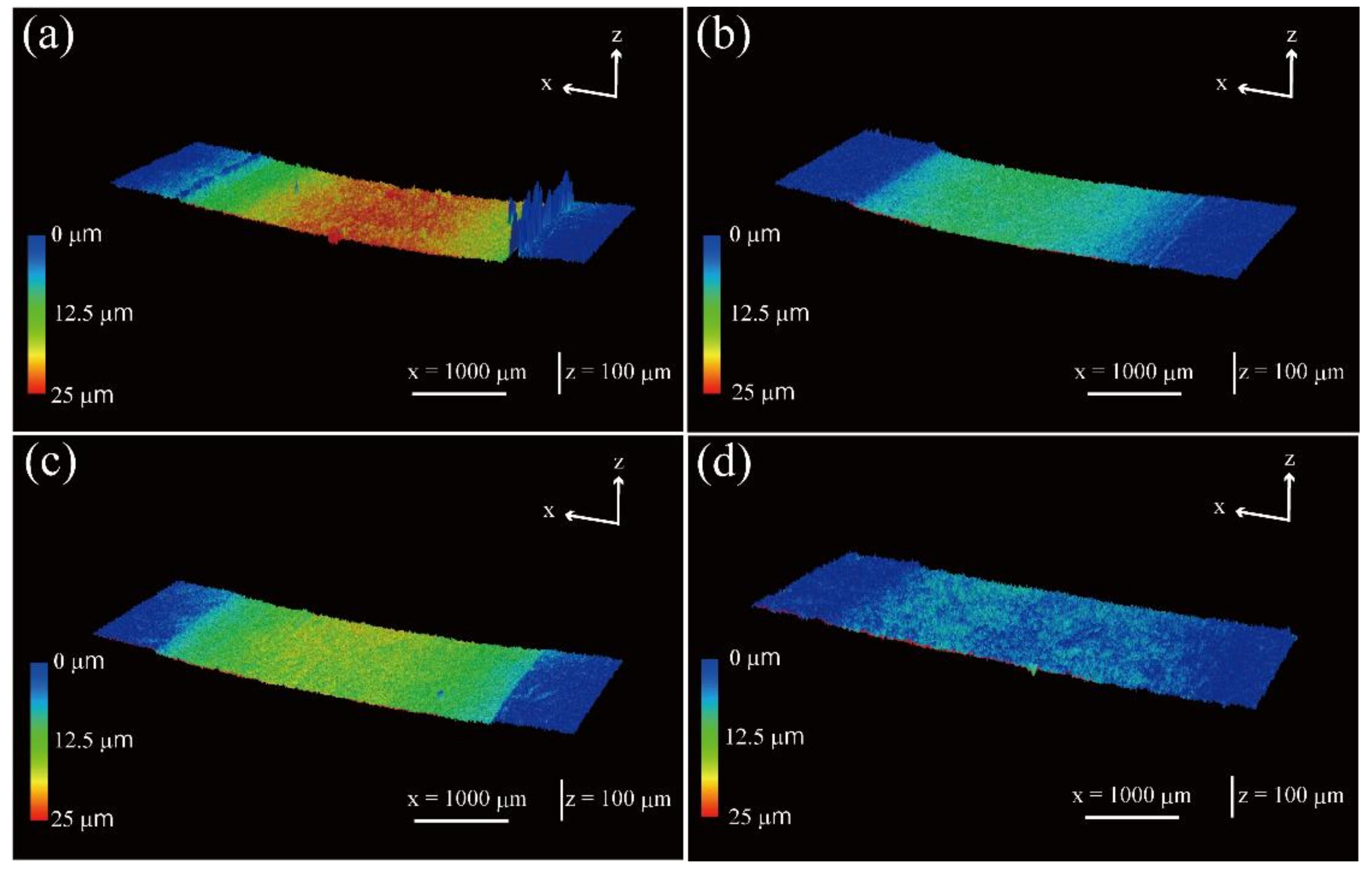
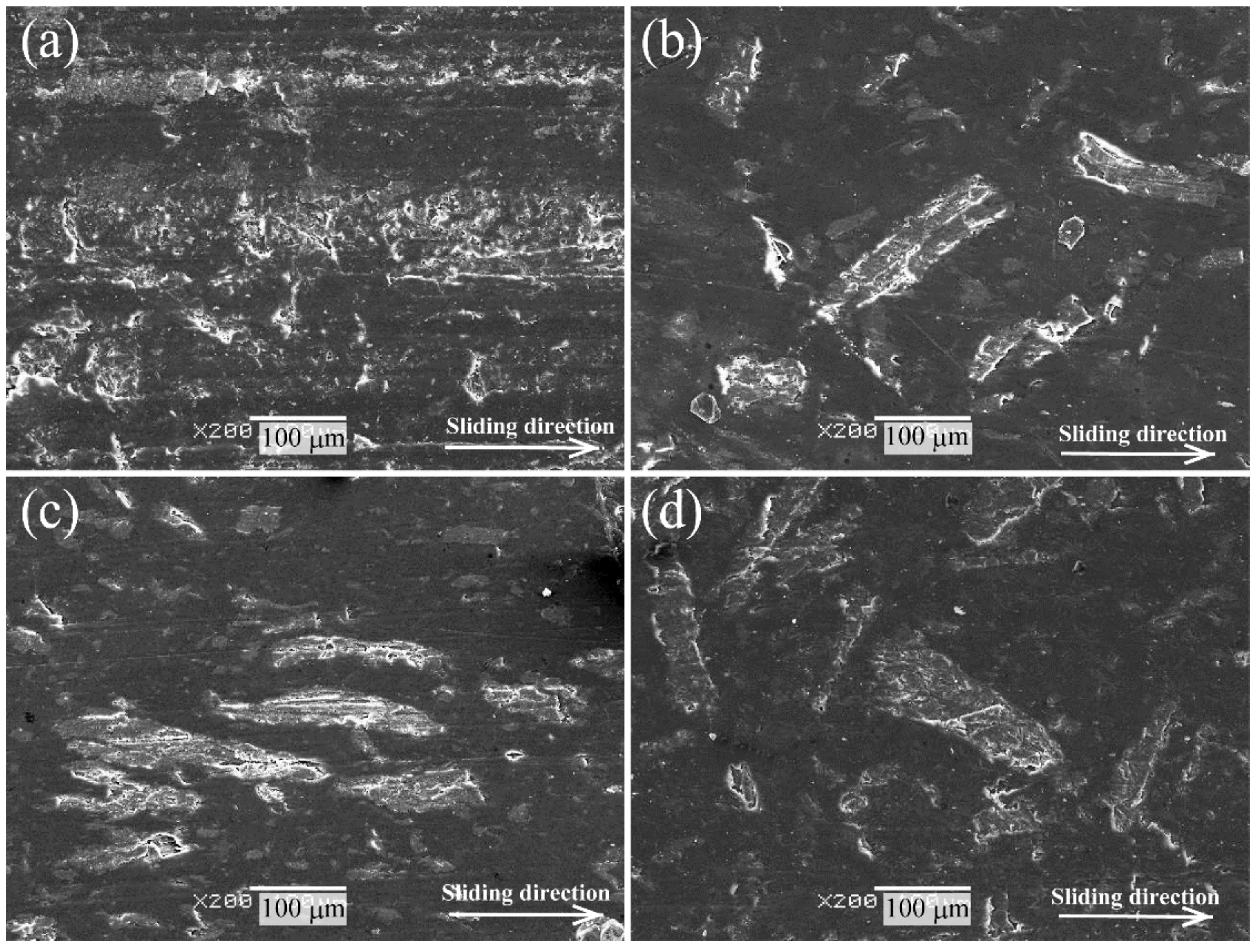

| Temperature (°C) | HF_NaClO2 | HF_NaClO2 + EP | HF_NaClO2 + A-1160 | HF_NaClO2 + A-1160 + EP |
|---|---|---|---|---|
| 10 wt % loss | 340.1 | 342.9 | 354.1 | 357.2 |
| 15 wt % loss | 362.2 | 362.3 | 370.4 | 373.2 |
| Code | PA1010 (Vol %) | Hemp Fiber (Vol %) | Alkaline Treatment (NaClO2) | Ureidosilane Coupling Agent (A-1160) | Epoxy Resin (EP) Treatment |
|---|---|---|---|---|---|
| HF_NaClO2 | 80 | 20 | ○ | − | − |
| HF_NaClO2 + EP | 80 | 20 | ○ | − | ○ |
| HF_NaClO2 + A-1160 | 80 | 20 | ○ | ○ | − |
| HF_NaClO2 + A-1160 + EP | 80 | 20 | ○ | ○ | ○ |
Publisher’s Note: MDPI stays neutral with regard to jurisdictional claims in published maps and institutional affiliations. |
© 2021 by the authors. Licensee MDPI, Basel, Switzerland. This article is an open access article distributed under the terms and conditions of the Creative Commons Attribution (CC BY) license (http://creativecommons.org/licenses/by/4.0/).
Share and Cite
Morino, M.; Kajiyama, T.; Nishitani, Y. Influence of Epoxy Resin Treatment on the Mechanical and Tribological Properties of Hemp-Fiber-Reinforced Plant-Derived Polyamide 1010 Biomass Composites. Molecules 2021, 26, 1228. https://doi.org/10.3390/molecules26051228
Morino M, Kajiyama T, Nishitani Y. Influence of Epoxy Resin Treatment on the Mechanical and Tribological Properties of Hemp-Fiber-Reinforced Plant-Derived Polyamide 1010 Biomass Composites. Molecules. 2021; 26(5):1228. https://doi.org/10.3390/molecules26051228
Chicago/Turabian StyleMorino, Maiko, Tetsuto Kajiyama, and Yosuke Nishitani. 2021. "Influence of Epoxy Resin Treatment on the Mechanical and Tribological Properties of Hemp-Fiber-Reinforced Plant-Derived Polyamide 1010 Biomass Composites" Molecules 26, no. 5: 1228. https://doi.org/10.3390/molecules26051228
APA StyleMorino, M., Kajiyama, T., & Nishitani, Y. (2021). Influence of Epoxy Resin Treatment on the Mechanical and Tribological Properties of Hemp-Fiber-Reinforced Plant-Derived Polyamide 1010 Biomass Composites. Molecules, 26(5), 1228. https://doi.org/10.3390/molecules26051228






